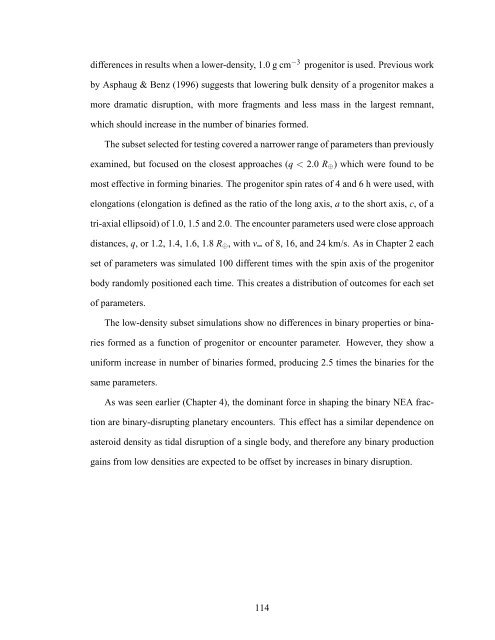Forming Binary Near-Earth Asteroids From Tidal Disruptions
Forming Binary Near-Earth Asteroids From Tidal Disruptions
Forming Binary Near-Earth Asteroids From Tidal Disruptions
Create successful ePaper yourself
Turn your PDF publications into a flip-book with our unique Google optimized e-Paper software.
differences in results when a lower-density, 1.0 g cm −3 progenitor is used. Previous workby Asphaug & Benz (1996) suggests that lowering bulk density of a progenitor makes amore dramatic disruption, with more fragments and less mass in the largest remnant,which should increase in the number of binaries formed.The subset selected for testing covered a narrower range of parameters than previouslyexamined, but focused on the closest approaches (q < 2.0 R ⊕ ) which were found to bemost effective in forming binaries. The progenitor spin rates of 4 and 6 h were used, withelongations (elongation is defined as the ratio of the long axis, a to the short axis, c, of atri-axial ellipsoid) of 1.0, 1.5 and 2.0. The encounter parameters used were close approachdistances, q, or 1.2, 1.4, 1.6, 1.8 R ⊕ , with v ∞ of 8, 16, and 24 km/s. As in Chapter 2 eachset of parameters was simulated 100 different times with the spin axis of the progenitorbody randomly positioned each time. This creates a distribution of outcomes for each setof parameters.The low-density subset simulations show no differences in binary properties or binariesformed as a function of progenitor or encounter parameter. However, they show auniform increase in number of binaries formed, producing 2.5 times the binaries for thesame parameters.As was seen earlier (Chapter 4), the dominant force in shaping the binary NEA fractionare binary-disrupting planetary encounters. This effect has a similar dependence onasteroid density as tidal disruption of a single body, and therefore any binary productiongains from low densities are expected to be offset by increases in binary disruption.114












